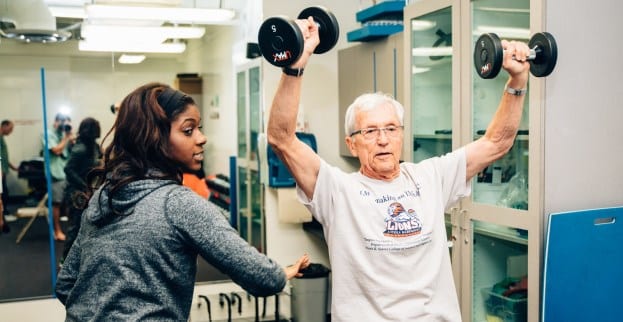
Life saving. Live changing. Best program around. These are words being used to describe a collaborative research project underway at the Frank R. Seaver College of Science and Engineering that is identifying ways exercise can help cancer survivors strengthen their bodies and promote improved survival prognosis.
“This past Thanksgiving I went to Boston with my family and was able to make it to the top of the Bunker Hill Monument,” recalled Ann Cortez, a cancer survivor and participant in the program since it began in 2013. “I made it up the full 300 steps with my family, something I couldn’t enjoy with them before. This is the impact of the program.”
The program is called IMPAACT, Improving Physical Activity After Cancer Treatment. Cancer survivors participate in one-hour supervised exercise sessions consisting of aerobic and resistance training three times a week at Loyola Marymount’s Applied Physiology Lab. Initial results showed that body fat and waist circumference decreased, bone density improved and participants made noticeable gains in flexibility and strength.
“What we’ve found so far is that the program is improving the overall health of the participants,” said Heather Tarleton, an assistant professor in the Health and Human Sciences Department who led the study.
The finding that exercise improves health may not appear to be groundbreaking, but for cancer survivors—who often suffer fatigue, pain, nausea and other side effects of their treatment—the results are encouraging. “They are feeling more fully engaged in life,” Tarleton said of the participants. “That will improve their chances of staying healthy for a longer time.”
Proactively Addressing Cancer
“When you get cancer, you are immediately awash in the process of having cancer. It’s all pretty passive for the patient and really terrifying,” explained participant Linda Jacobson, who joined IMPAACT last August. “This program gives some concrete ways to address the cancer in a proactive way.”
Fay Lyons, a cancer survivor who participated in a similar program at Cedars Sinai, compares IMPAACT to “circuit training at an expensive gym.” Since joining, Lyons has noticed an improvement in her endurance, muscle tone and sleep. “I feel like I have 10 personal trainers in the room.”
Participants have target goals customized to the individual, explained Tarleton. This is something participants have valued, as each has experienced the effects of cancer treatment to differing extents.
“Anything I struggled with, they modified for me,” said Cortez. “Any cancer survivor should know they can come to the program and take it one step at a time, based on what their body needs.”
Beyond Physical Benefits
The benefits of IMPAACT go beyond the physical, as participants point to the camaraderie that’s developed from exercising with other cancer survivors. “The anecdotal sharing of stories and experiences with another person who ‘gets it’ is healing,” said Jacobson.
“For me it became more than just a regular program. It was a place I could go and feel comfortable while I was recovering with others in a similar situation. The help I received from all the staff and students, and the support I received from the other participants, were a big bonus,” said Deanna Schultz.
IMPAACT is a collaborative project among several faculty members. Tarleton is the lead investigator and focuses on blood biomarkers and body composition. Hawley Almstedt studies bone health and body composition. Silvie Grote looks at cardiovascular health and balance. Stephanie Perez hones in on the neurological assessment and neuropathy, as well balance. Todd Shoepe focuses on musculoskeletal health. Sarah Strand carries out the orthopedic assessment and also studies balance.
A cadre of student research assistants—34 since IMPAACT started—also supports the program by monitoring participants and collecting data.



